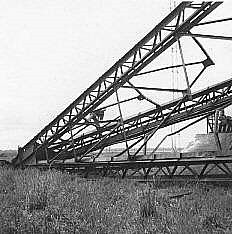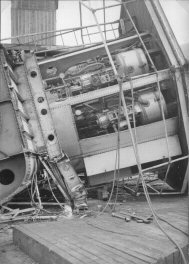1966 : the scarpping |
On 12 April 1962, the original propeller was dismantled and replaced by a slim, faster propeller to eliminate a gear train.
Pierre Jean Cavey had left BEST on 30 April 1960 to take over the management of the Flambo factory at Nogent-le-Roi but he continued to visit the station from time to time to meet his successor Marc Leguillette. We have no written documentation or photographs from this period so we have to rely on memory.
The same year the propeller was changed, during a test run, one of the blades broke off due to mechanical fatigue caused by self-sustained vibrations. Luckily the turbine was oriented in such a way that the detached blade was able to mow down a neighbouring field without causing any casualties.
This type of accident is quite common in the history of high-power wind turbines. The first propeller had a nominal tip speed of about Mach 0.3. The next one reached Mach 0.45. At this speed, the major risk is that the propeller will resonate. Emergency shutdown of the machine is the only solution if there is time. Similarly, tests of variable pitch propellers, which are more fragile, have all resulted in the loss of a blade and the destruction of the machine.
According to Lucien Romani, the reasonable limit of the speed at the tip of the blade is about 100 m/s or 360 Km/h (Mach 0.3). As the nursery rhyme says:
Meunier tu dors
Ton moulin, ton moulin va trop vite
Meunier, tu dors
Ton moulin, ton moulin va trop fort.
Miller, you sleep
Your mill, your mill goes too fast
Miller, you are sleeping
Your mill, your mill goes too fast.
But the Nogent-le-Roi turbine was robust. Whereas the loss of a blade on a moving propeller everywhere else had led to the destruction of the turbine due to damage to both the generator and the superstructure, the Nogent turbine held up well.
The BEST and EDF studied the possibility of putting it back into service. In the magazine "Les Cahiers de l'Iroise", published by Yves Peslin, André Argand testifies: "I even bought for Electricité de France, 4 hectares near Trémazan (in Landunvez) to transport there a huge test windmill, directly feeding the general electricity network, previously installed near Chartres". But the project was quickly abandoned. The very low cost of oil gave it, at the time, an undeniable economic superiority over renewable energy. Nuclear energy was beginning to emerge and was mobilising all the minds at the EDF Research Department, especially as COGEMA was exploiting a uranium deposit near Limoges, which gave hope of an appreciable indigenous resource and a reduction in the cost of energy imports. Pierre Ailleret was about to retire and his successor was not very keen on wind energy.
However, there was talk of dismantling the wind generator and reinstalling it in Saint-Pierre-et-Miquelon. This new life was not followed up because of the distance between this overseas territory and the mainland, which precluded regular monitoring by both EDF and the BEST.
Left abandoned for three years, in the spring of 1966, the wind turbine was finally delivered to the scrap merchants and the field returned to its owner, the farmer from Vaubrun.
The photographs below were taken by Pierre Jean Cavey on 21 May 1966. Some of them show the equipment in the nacelle and the pivot.
 |
|
| The local press announces the event (Source : Mr Roger Tempète) | |
 |
 |
| The tripod on the ground | |
 |
 |
| The wind turbine was pulled to the ground by the scrap dealers without dismantling | |
 |
 |
| Pivot and nacelle on the ground. The alternator in its housing and the clutch can be seen. | |
 |
 |
| The hydraulic devices located in the pivot at the base of the nacelle. | |
 |
 |
| The pinion of a gear train | The cylinder reads "Propriété de EDF". |
 |
 |
| In July 1966, nothing remained of the wind turbine. Only the buildings and the resistance line, which served as an electric brake, remained for a short time. | |